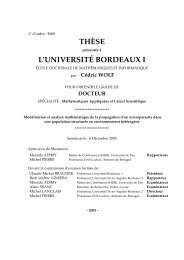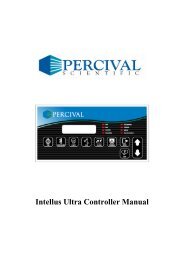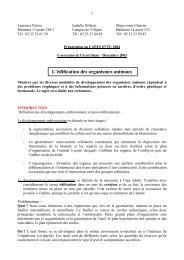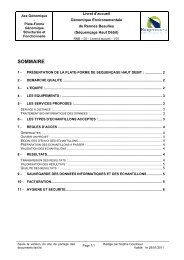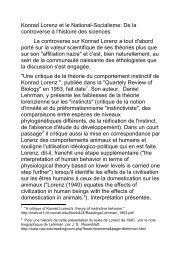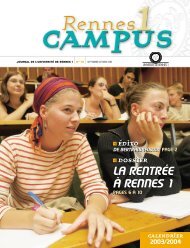1 CHIRONOMUS NEWSLETTER ON CHIRONOMIDAE RESEARCH ...
1 CHIRONOMUS NEWSLETTER ON CHIRONOMIDAE RESEARCH ...
1 CHIRONOMUS NEWSLETTER ON CHIRONOMIDAE RESEARCH ...
You also want an ePaper? Increase the reach of your titles
YUMPU automatically turns print PDFs into web optimized ePapers that Google loves.
REARING TANYPODINAE, TELMATOGET<strong>ON</strong>INAE AND ORTHOCLADIINAE IN<br />
BRAZIL – AN EMPIRICAL APPROACH.<br />
This text reflects my experience in rearing<br />
chironomids in Brazil.<br />
Just after sorting, the larvae were isolated in<br />
small vials in order to be sure about the<br />
associations. The vials stayed open and as soon<br />
as the larvae became pupae, the larval exuviae<br />
was fixed and the pupa transferred to a larger<br />
container with a lower superficial tension<br />
(provided by the superficial area) so they could<br />
emerge. The vials suggested by EPLER (1995;<br />
2001) and by MERRIT, RESH & CUMMINS<br />
(1996) weren’t efficient for most of the<br />
chironomids I’ve tried unsuccessfully to rear.<br />
Transport from field to laboratory:<br />
I’ve got good results with isolated larvae in ice<br />
coolers to keep the temperature low. The water<br />
level in the vials must be low so it facilitates<br />
gas exchange and prevent mechanical shock,<br />
and a substratum should be provided for the<br />
larvae (avoiding extra stress).<br />
Temperature in the laboratory:<br />
Most chironomids live well at room<br />
temperatures, even the ones collected in<br />
streams. The main problem is not the<br />
temperature, but the water level which is<br />
related to oxygen. I’ve reared some fastflowing<br />
chironomids with very low water<br />
levels in the vials.<br />
Association of the larvae with the<br />
environment:<br />
The chironomids associated with soft substrata,<br />
as a whole, need at least a fine layer of<br />
substratum where they can move and build<br />
their tubes. Coelotanypodini and Procladiini<br />
don`t build tubes, but they arrange the<br />
sediment into “paths” in which they can hide.<br />
The chironomids associated with submerged<br />
vegetation and macrophytes need an<br />
appropriate substratum to live on. An easy way<br />
to solve this problems is to incorporate some<br />
small leaf pieces to serve as substratum for the<br />
larvae.<br />
Most of orthoclads live in streams, springs and<br />
other fast flowing waters. One easy way to rear<br />
them is by keeping them in small vials with<br />
By Humberto Fonseca Mendes<br />
Departamento de Biologia da FFCLRP/USP<br />
Av. Bandeirantes, 3900 Ribeirão Preto – SP<br />
CEP 14040-901<br />
E-mail: hfmendes@usp.br<br />
29<br />
shallow water, another way is by placing them<br />
in a flowing water system with enough oxygen.<br />
Many orthoclads live in “non-aquatic”<br />
environments (some are semi-aquatic, semiterrestrial,<br />
terrestrial or marine) in these special<br />
environments, rearing methods must be as<br />
similar as possible to the environments where<br />
they were collected.<br />
In streams and fast flowing waters the larvae<br />
must be sorted as soon as possible, these<br />
environments are generally very rich in oxygen<br />
and the larvae are very demanding in this<br />
parameter. The vials must be with little water,<br />
generally when full of it, the relationship of<br />
depth to surface area is such that there isn’t<br />
enough oxygen provided. Another way to do<br />
this is keeping the animals in flowing water.<br />
Larvae of slow flowing to standing waters are,<br />
generally, more resistant to oxygen depletion,<br />
some can survive in very low concentrations of<br />
oxygen, like Chironomus. Most of these<br />
animals require a fine layer of sediment in the<br />
bottom of the vial. Some animals from<br />
standing waters and pools live on macrophytes,<br />
stones, dead leaves and submerged trunks, for<br />
them the best was to take a piece of leaf to set<br />
in the vials with the larvae.<br />
Phytotelmata are generally good sources for<br />
chironomids. I’ve collected some chironomids<br />
in the leaf axils of bromeliads, and the best<br />
results were obtained by washing the<br />
substratum with a sieve as soon as it was taken<br />
from the leaf. Washing can be conducted with<br />
filtered water. Also, the animals might be<br />
placed in a white tray, sorted and isolated in<br />
the field. For more about phytotelmata<br />
chironomids see FRANK (1983).<br />
The mining chironomids, like<br />
Stenochironomus, should never be taken out of<br />
their places; most of them aren’t able to<br />
continue mining after they have been taken<br />
out. One way to solve this problem is to keep<br />
some submerged trunks and leaves in the<br />
laboratory (emergence trails) and wait till the<br />
animals emerge. More information on the<br />
Chironomidae associated with submerged



